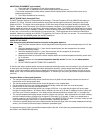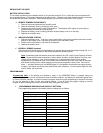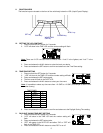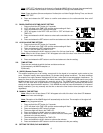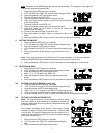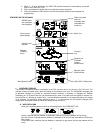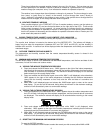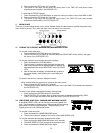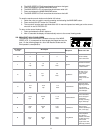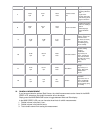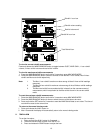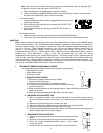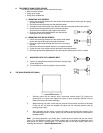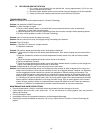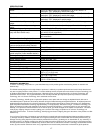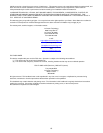
14
Note: When in the 12-hour mode and setting an alarm for a time between noon and midnight, “PM”
will appear to the left of the alarm time in the DATE LCD.
4. Press and release the OUT/MIN button to adjust the minutes.
5. Press and release the WIND/RAIN/SNZ button to confirm the setting or wait for 20 seconds and
the display will automatically return to the normal mode.
To activate the alarm:
1. Press and release the ALM/+ button to toggle between the alarm time
and the day and date.
2. When the alarm time and alarm icon are showing in the DATE LCD
the alarm is activated.
3. When the day and date are showing in the DATE LCD the alarm is
deactivated.
To activate the snooze:
1. While the alarm is sounding press and release the WIND/RAIN/SNZ button.
2. The snooze will be activated and the alarm will come back on after the selected time period.
MOUNTING
Note: Before permanently mounting ensure that the indoor weather station is able to receive WWVB signals
from the desired location. Also, extreme and sudden changes in temperature will decrease the accuracy of
the indoor weather station, and changes in elevation will result with inaccurate weather forecasting for the
next 12 to 24 hours. These changes will require a 12 to 24 hour wait before obtaining reliable data. To
achieve a true temperature reading, avoid mounting where direct sunlight can reach the remote
temperature/humidity sensor or indoor weather station. While the remote temperature/humidity sensor is
weather proof, avoid submersion in water or snow. We recommend that you mount the remote
temperature/humidity sensor on an outside North-facing wall. The sending range is 330ft—obstacles such as
walls, concrete, and large metal objects can reduce the range. Place both units in their desired location, and
wait approximately 15 minutes before permanently mounting to ensure that there is proper reception. The
indoor weather station should display a temperature and humidity in the OUTDOOR LCD and wind speed
(can be 0.0) in the WIND SPEED LCD within 4 minutes of setting up.
I. THE REMOTE TEMPERATURE/HUMIDITY SENSOR
The remote temperature/humidity sensor can be mounted in several ways:
• With the use of screws
• Using adhesive tape
• Using nylon straps
A. MOUNTING WITH SCREWS
1) Remove the mounting bracket from the remote
temperature/humidity sensor.
2) Place the mounting bracket over the desired location.
3) Through the two screw holes of the bracket, mark the mounting
surface with a pencil.
4) Screw mounting bracket onto the mounting surface. Ensure that the screws are tight
against the bracket.
5) Insert the remote temperature/humidity sensor into the bracket.
B. MOUNTING WITH ADHESIVE TAPE
1) With a nonabrasive solution, clean and dry the back of the mounting bracket and the
mounting surface to ensure a secure hold. The mounting surface should be smooth and
flat.
2) Remove the protective strip from one side of the tape.
3) Adhere the tape to the designated area on the back of the mounting bracket.
4) Remove the protective strip from the other side of the tape.
5) Position the remote temperature/humidity sensor in the desired location, ensuring that the
indoor weather station can receive the signal.
C. MOUNTING WITH NYLON STRAPS
1) Remove the mounting bracket from the remote temperature/humidity
sensor.
2) Place two nylon straps through the slots on the mounting bracket.
3) Place the remote temperature/humidity sensor in your desired
mounting location.
4) Fasten the two nylon straps securely around the mounting location.



